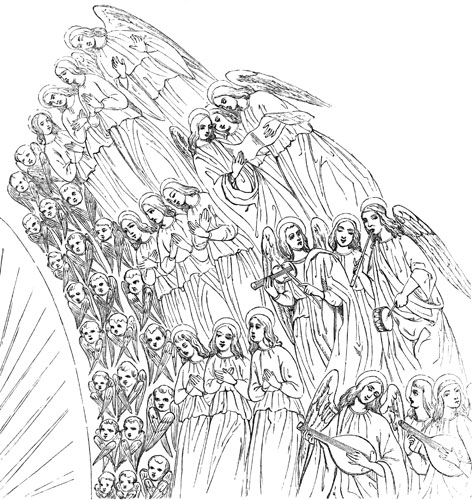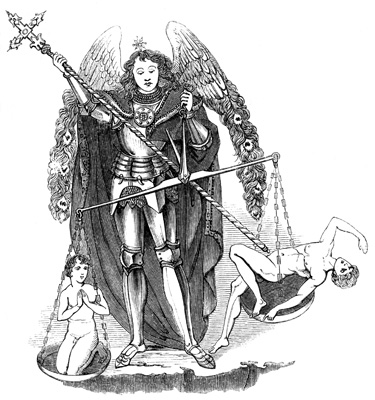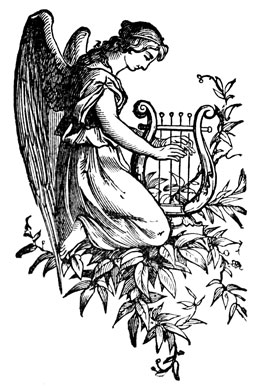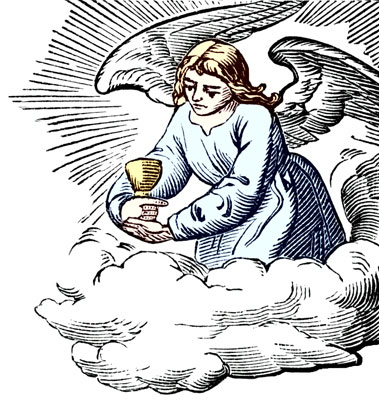There have been many curious conceits introduced into some of the early religious pictures, and two instances in which little seraphim and angels are perched on trees, near the Virgin and Holy Child. The idea seems to be that these “Birds of God” — as Dante calls the angels — are making music and singing for the Divine Infant, some of them also praying for his solace. . . . → Read More: Seven Holy Angels
|
|
|||
|
The representations of St. Michael as the Lord of Souls are less numerous than those of the subjects mentioned in Part 1, but are very interesting. In some votive pictures he appears as the protector of those who have struggled with evil, and gained a victory. In such pictures the angel has his foot upon the dragon, or holds a dragon’s head in his hand, and bears the banner of victory. . . . → Read More: Archangel Michael: Part 2
The Archangel Gabriel is mentioned by name but twice in the Old Testament. First in Daniel viii., 16, when he explained the vision which the prophet had seen, and again in Daniel ix., 21, when Gabriel appeared to Daniel to give him skill and understanding. Likewise in the New Testament he is twice mentioned– in Luke i., 19 and 26, when he announced to Zacharias the birth of John the Baptist, and to the Virgin Mary that she was favored of the Lord, and blessed among women. On each of those occasions he filled the office of a messenger or bearer of important tidings. . . . → Read More: Archangel Gabriel: Part 1
There are several angels who in artistic representations have assumed an individual form and character. These belong to the order of Archangels, placed by Dionysius in the third Hierarchy: they take rank between the Princedoms and the Angels and partake of the nature of both. Like the Princedoms, they have Powers; and, like the Angels, they are Ministers and Messengers. Frequent allusion is made in Scripture to the seven Angels who stand in the presence of God. (Rev. viii. 2, xv. 1, xvi. 1, etc.; Tobit xxii. 15.) This was in accordance with the popular creed of the Jews, who not only acknowledged the supremacy of the Seven Spirits, but assigned to them distinct vocations and distinct appellations, each terminating with the syllable El, which signifies God. . . . → Read More: Archangels: Part 1 The Supernatural in the Angelic World Supernatural Vocation of the Angels I. Holy Scripture hints that all the angels were called to the vision of God, when it represents the good angels as actually seeing His Face, and only excludes the fallen ones of from that privilege. Such is also the common tradition embodied in the opinion that man was called to fill the places left vacant by the fallen angels. . . . → Read More: Bible Angels: Part 4 Number and Hierarchy of the Angels Number of the Angels I. We are certain, from Revelation. that the number of Angels is exceedingly great, forming an army worthy ot the greatness of God. This army of the King of heaven is mention in Deut. xxx. 2; then in the vision of Daniel (vii. 10), and in many other places. How Many Kinds? II. If the Angels can be numbered, there must exist between them at least personal differences; that is to say, each angel has his own personality. But whether they are all of the same kind, like man, or constitute several kinds, or are each of a different kind or species, is a question upon which Theologians differ. . . . → Read More: Bible Angels: Part 3 Attributes of the Angels—Incorruptibility and Relation to Space The attributes of the Angels, like the nature of their substance, are to be determined by a comparison with the attributes of God on the one hand, and with the attributes of man on the other. As creatures, the Angels partake of the imperfections of man; as pure spirits, they partake of the perfections of God. . . . → Read More: Bible Angels: Part 2 The Nature, Existence, and Origin of the Angels Terminology I. The name “ Angel”—that is, messenger or envoy—designates an office rather than a nature, and this office is not peculiar to the beings usually called Angels. Holy Scripture, however, and the Church have appropriated this name to them, because it represents them as standing between God and the rest of the universe, above man and nearer to God on account of their spiritual nature, and taking a share in the government of this world, although absolutely dependent on God. . . . → Read More: Bible Angels: Part 1 |
|||
|
Copyright © 2024 Christian Image Source - All Rights Reserved |
|||

 Archangel Michael
Archangel Michael
 Archangel Pictures
Archangel Pictures




Guardian Angels
The Angel of Peace by Wilhem von Kaulbach
From the classification of the angelic hosts by the early theologians, and the special duties assigned to each class, we learn that the word angels, as ordinarily used, refers to archangels and angels only; these two classes are associated with human life in all its phases . . . . . . → Read More: Guardian Angels